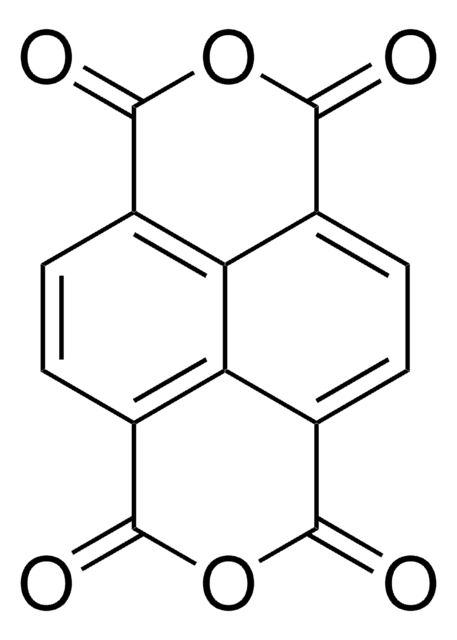932760
3,4,9,10-Perylenetetracarboxylic dianhydride
Synonyme(s) :
PTCDA, Perylenetetracarboxylic acid dianhydride, Perylene-3,4,9,10-tetracarboxylic dianhydride, Pigment Red 224
About This Item
Produits recommandés
Pureté
99% (sublimed)
Niveau de qualité
Pf
>300 °C
Solubilité
DMSO: slightly soluble
Énergie orbitale
HOMO 5.85 eV
LUMO 3.9 eV
InChI
1S/C24H8O6/c25-21-13-5-1-9-10-2-6-15-20-16(24(28)30-23(15)27)8-4-12(18(10)20)11-3-7-14(22(26)29-21)19(13)17(9)11/h1-8H
Clé InChI
CLYVDMAATCIVBF-UHFFFAOYSA-N
Vous recherchez des produits similaires ? Visite Guide de comparaison des produits
Application
The compound has attracted much interest as an organic semiconductor. It has potential applications in organic and molecular electronics, and typically used as an archetype molecular compound. PTCDA shares many properties with conventional semiconductors (with their delocalized electronic states), and insulator-like organic molecular crystals (OMCs) (with their large absorption oscillator strengths, excitonic self-trapping, polaron-assisted conduction, etc.). That is due to extremely close π-π stacking, an unusually small intermolecular distance of only 3.21 A. Among its applications, it is important to highlight the latest focus on environment monitoring, self-assembly and photocatalysis.
Code de la classe de stockage
11 - Combustible Solids
Classe de danger pour l'eau (WGK)
WGK 1
Certificats d'analyse (COA)
Recherchez un Certificats d'analyse (COA) en saisissant le numéro de lot du produit. Les numéros de lot figurent sur l'étiquette du produit après les mots "Lot" ou "Batch".
Déjà en possession de ce produit ?
Retrouvez la documentation relative aux produits que vous avez récemment achetés dans la Bibliothèque de documents.
Notre équipe de scientifiques dispose d'une expérience dans tous les secteurs de la recherche, notamment en sciences de la vie, science des matériaux, synthèse chimique, chromatographie, analyse et dans de nombreux autres domaines..
Contacter notre Service technique






![9,9-Bis[4-[(4-ethenylphenyl)methoxy]phenyl]-N2,N7-di-1-naphthalenyl-N2,N7-diphenyl-9H-Fluorene-2,7-diamine ≥98% (HPLC)](/deepweb/assets/sigmaaldrich/product/structures/217/694/0386f9cf-a92c-48f3-bde7-f7a23d7cdc3a/640/0386f9cf-a92c-48f3-bde7-f7a23d7cdc3a.png)